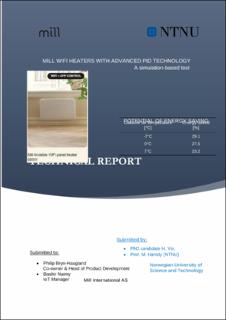| dc.contributor.author | Mohamed, Mohamed Hamdy Hassan | |
| dc.contributor.author | Yin, Hang | |
| dc.date.accessioned | 2023-10-23T05:20:32Z | |
| dc.date.available | 2023-10-23T05:20:32Z | |
| dc.date.created | 2023-10-20T09:51:23Z | |
| dc.date.issued | 2023 | |
| dc.identifier.uri | https://hdl.handle.net/11250/3097932 | |
| dc.description.abstract | In Norway, buildings sector accounts for 34% of the total energy consumption [1]. Where, over 84% of residential building’s energy consumption has been covered by direct/indirect electricity (i.e., electric heaters / heat pumps). According to the EN ISO 52120-1 Standard [2], Building Automation and Control Systems (BACS) can significantly impact on energy use of buildings and their occupants. In recognition to this fact, the Norwegian Wi-Fi heaters developer (Mill International AS) developing new generations of Wi-Fi heaters that can reducing the heating demands by re-setting the heating temperature setpoint whenever possible. In this report, NTNU tests the potential of energy saving that can be achieved by the third generation of Mill Wi-Fi heaters with their advanced PID technology. | |
| dc.description.abstract | MILL wifi Heaters with Advanced PID Technology: A simulation-based test | |
| dc.language.iso | eng | |
| dc.publisher | Norwegian University of Science and Technology | |
| dc.title | MILL wifi Heaters with Advanced PID Technology: A simulation-based test | |
| dc.title.alternative | MILL wifi Heaters with Advanced PID Technology: A simulation-based test | |
| dc.type | Research report | |
| dc.description.version | submittedVersion | |
| dc.source.pagenumber | 11 | |
| dc.identifier.cristin | 2186639 | |
| dc.relation.project | Norges forskningsråd: 257660 | |
| dc.relation.project | Norges teknisk-naturvitenskapelige universitet: 2652119 | |
| cristin.ispublished | true | |
| cristin.fulltext | preprint | |
